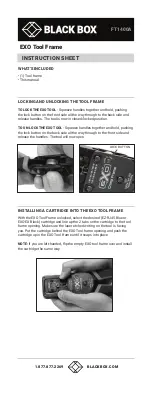
2.
Slide the Lock Key in until it engages the lock nut. You may need to rotate the lock
key slightly to align it with the internal hex of the lock nut. Rotate the Lock Key
counterclockwise several turns to assure the lock nut is fully disengaged from the
adjustment nut and that there is sufficient travel available for the adjustment nut to
attain the torque setting desired.
3.
Install the interchangeable head on the wrench. Engage the wrench to the tester
and click the wrench once or
twice while noting the
readings. To adjust the
wrench to a higher torque
setting, rotate the Torque
Adjustment Key clockwise. To
adjust the wrench to a lower
torque setting, rotate the
Torque Adjustment Key
counter-clockwise. Torque
adjustments should be made
in small increments with
several checks made
between each movement of the Torque Adjustment Key.
4.
Once the desired torque has been attained, hold the Torque Adjustment Key steady and rotate the Lock Key
clockwise until the lock nut firmly engages the torque adjustment nut, locking it in place. Remove the CART from
the wrench and perform a final torque check on the tester. When the reading matches the desired torque and the
lock nut is firmly engaged to the torque adjustment nut, the procedure is complete.
Radio Communications - 2.4 GHz Communication Overview
These tools use the 2.4GHz band for communication with the controller. As with all radio communications, there are
limits on the distance at which reliable bi-directional communication may be obtained. Physical barriers such as steel
framing, sheet metal and other objects that impede radio waves can signifi cantly reduce the reliable communication
distance. Another factor affecting the reliability and distance combination is the radio environment in which the unit will
be used.
The controller and torque wrench may operate on any of the 12 channels these products use. It is generally best to
think about this even before the unit is installed.
The radio modules in the controllers and torque wrenches used with them comply with the IEEE 802.15.4 standard.
The channel numbers loosely match the channels used by the IEEE 802.11b/g WLAN standard. It may be benefi cial
to use channels that do not match the channels used by a nearby wireless network. The graph below depicts both
standards and illustrates the center frequencies and channel overlap for each standard.
P/N 857331 B Revised 6/30/15























